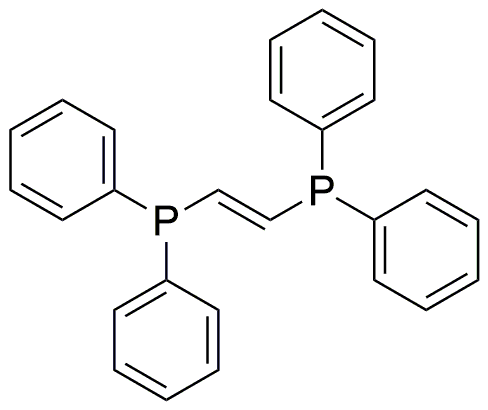trans-1,2-Bis(diphenylphosphino)ethylene is widely utilized in research focused on:
- Catalysis: This compound serves as a highly effective ligand in various catalytic processes, particularly in transition metal catalysis, enhancing reaction rates and selectivity.
- Organic Synthesis: It is employed in the synthesis of complex organic molecules, providing a means to create new chemical bonds with precision, which is crucial in pharmaceutical development.
- Material Science: The compound is used in the development of advanced materials, including polymers and nanomaterials, due to its ability to modify properties and improve performance.
- Coordination Chemistry: It plays a significant role in forming stable complexes with metal ions, which are essential in various applications, including sensors and electronic devices.
- Research and Development: Its unique properties make it a valuable tool in academic and industrial research, facilitating the exploration of new chemical reactions and mechanisms.
General Information
Properties
Safety and Regulations
Applications
trans-1,2-Bis(diphenylphosphino)ethylene is widely utilized in research focused on:
- Catalysis: This compound serves as a highly effective ligand in various catalytic processes, particularly in transition metal catalysis, enhancing reaction rates and selectivity.
- Organic Synthesis: It is employed in the synthesis of complex organic molecules, providing a means to create new chemical bonds with precision, which is crucial in pharmaceutical development.
- Material Science: The compound is used in the development of advanced materials, including polymers and nanomaterials, due to its ability to modify properties and improve performance.
- Coordination Chemistry: It plays a significant role in forming stable complexes with metal ions, which are essential in various applications, including sensors and electronic devices.
- Research and Development: Its unique properties make it a valuable tool in academic and industrial research, facilitating the exploration of new chemical reactions and mechanisms.
Documents
Safety Data Sheets (SDS)
The SDS provides comprehensive safety information on handling, storage, and disposal of the product.
Product Specification (PS)
The PS provides a comprehensive breakdown of the product’s properties, including chemical composition, physical state, purity, and storage requirements. It also details acceptable quality ranges and the product's intended applications.
Certificates of Analysis (COA)
Search for Certificates of Analysis (COA) by entering the products Lot Number. Lot and Batch Numbers can be found on a product’s label following the words ‘Lot’ or ‘Batch’.
*Catalog Number
*Lot Number
Certificates Of Origin (COO)
This COO confirms the country where the product was manufactured, and also details the materials and components used in it and whether it is derived from natural, synthetic, or other specific sources. This certificate may be required for customs, trade, and regulatory compliance.
*Catalog Number
*Lot Number
Safety Data Sheets (SDS)
The SDS provides comprehensive safety information on handling, storage, and disposal of the product.
DownloadProduct Specification (PS)
The PS provides a comprehensive breakdown of the product’s properties, including chemical composition, physical state, purity, and storage requirements. It also details acceptable quality ranges and the product's intended applications.
DownloadCertificates of Analysis (COA)
Search for Certificates of Analysis (COA) by entering the products Lot Number. Lot and Batch Numbers can be found on a product’s label following the words ‘Lot’ or ‘Batch’.
*Catalog Number
*Lot Number
Certificates Of Origin (COO)
This COO confirms the country where the product was manufactured, and also details the materials and components used in it and whether it is derived from natural, synthetic, or other specific sources. This certificate may be required for customs, trade, and regulatory compliance.


